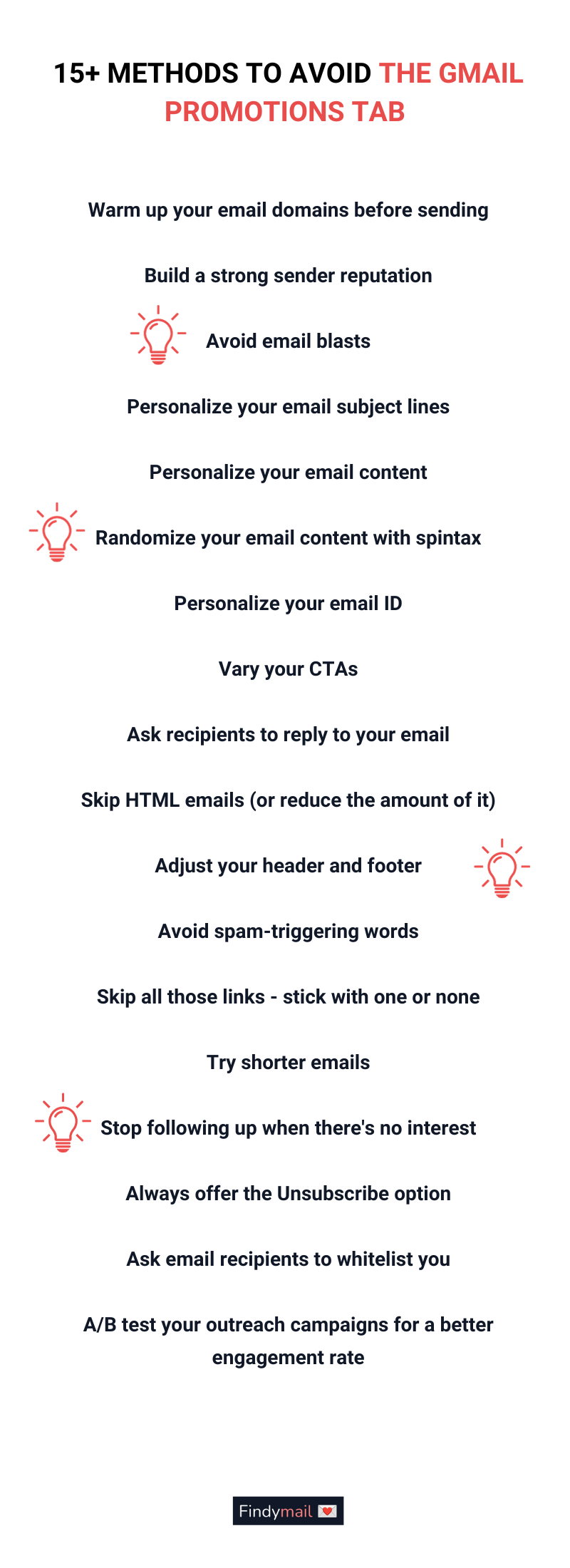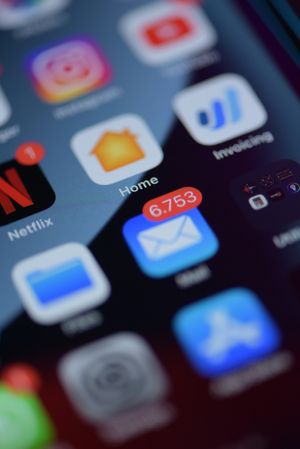The Promotions tab is the new spam folder. With 68% of all emails landing in the Promotions tab, your first sales mission will be to ensure you don’t end up there. Ever. But as the volume of outreach increases, what can you do to avoid the Gmail Promotions tab?
Let’s take a look at the 15+ best tactics to stay where you belong: in the Primary inbox!
Wait, Why Should I Avoid the Gmail Promotions Tab?
The best place to hide a body is on the second page of Google search results, and the best place to hide from a top-quality lead is in the Promotions tab. It’s where sales offers go to die, buried in the pile of newsletters, product updates, and other marketing material with ridiculously low open rates.
Your lead may check their Gmail Promotions tab once a week, only to groan at the sheer volume of emails there. If your email lands in Promotions, it'll be harder to grab their attention - even if your subject line is personalized and your body copy promises value.
In short: avoid the Gmail Promotions tab to give yourself a fair shot at success.
How Do I Know My Emails Will Land in the Promotions Tab?
Whether your emails will land in the Gmail promotions tab or the Primary inbox depends on your email deliverability and sender reputation.
Gmail (and other email service providers like Outlook) want to improve the user’s experience. A significant part of that is filtering emails for them: which ones require immediate attention, and which ones can wait until later?
Depending on your email domain’s sender reputation, the email service providers decide where to put your emails.
If they notice you send many similar emails and get low response rates, they take it to mean your emails aren’t that important to recipients.
Similarly, if your emails often bounce, that’s a signal, too.
The methods I’m about to show you focus on increasing your email deliverability and relevance so that your emails seem more natural and less promotional.

1. First Things First: Warm up Your Email Domains Before Sending
Sending a bunch of emails from a new domain won’t just land you in the Promotions tab - it could also put you in the Spam folder. Warm up the new cold email domains you’ll use for outreach.
Your reputation goes down if you suddenly start sending hundreds of emails from a new email address. Warmup steadily increases your send volume and reputation.
You can warm up your inbox manually or use cold email warmup tools.
Warmup builds your credibility (read: sender reputation) in front of email service providers.
The process includes automatically sending emails to verified recipients, engaging with them, pulling them out of the Promotions tab, and ensuring your email account looks like a bonafide user instead of making it clear you're cold-emailing.
2. Build a Strong Sender Reputation
We don’t talk about cold email metrics just because we want to sell more. The truth is, the more opens and responses we get, the stronger our sender reputation becomes and the easier it becomes to avoid the Gmail promotions tab.
Building a solid sender reputation starts with email warmup and following other methods in this article. Still, it would help if you also did the following:
- Don’t buy lead gen and email contact lists.
- Review your lead gen and contact lists often to remove invalid addresses, catch-all inboxes, and disinterested leads.
- Verify email addresses before you send the emails.
- Segment, target, and personalize your emails.
3. Automating Cold Outreach? Behave Like a Human
Avoid email blasts. When you send hundreds and thousands of emails at once that don’t vary in content or subject lines, email service providers take note and place you in the Promotions or Spam tabs.
Instead, segment your leads and don’t send the same email to too many leads.
Use a cold outreach tool to automate your sequences. It’ll make sure your emails have a reasonable cadence (a few now, a few after five minutes, and so on).
4. Personalize Your Email Subject Lines
If your subject line sounds too pitchy - and you send the same thing with minimal variation to every recipient - you’ll end up in the Gmail promotions tab.
Instead, avoid the Gmail promotions tab by personalizing your subject lines. Reference and personalize contact database data, including:
- Their challenges and goals
- Company news
- Team member names
- Competitors
- Your social proof
Remember: the goal is to make the email sound like you’re talking to the lead one-on-one. Not only will that increase your open rate, but that increase will also make email service providers place you in the Primary tab by default.
5. Personalize Your Email Content to Avoid the Gmail Promotions Tab
Personalize everything: the cold email icebreaker, the pitch, the information.
Not only will your emails be more useful to the recipients, but they’ll also sound more unique to email service providers. And when recipients engage with your email, service providers take it to mean that your content is worthy of the Primary tab.
Use a cold outreach automation tool to do it at scale.
And speaking of unique content…
6. Randomize Your Email Content with Spintax
In addition to personalizing, randomize. Even if your value prop is personalized to each recipient, the rest of your content stays the same.
On the other hand, spintax will choose from different options for different sections in your email. From the greeting to the signature, you can randomize everything.
That way, your emails will look unique to email service providers - even if you’re automating templates.
7. Personalize Your Email ID
Don’t use a generic email ID like [email protected].
Instead, ensure you’re emailing the recipient from your account - [email protected].
After all, you wouldn’t send a legitimate, unique email meant for the recipient from a catch-all address.
8. Vary Your CTAs to Avoid the Gmail Promotions Tab
Your email copy can be personalized, but if you always use the same call to action (or a call-to-action button) featuring promotional words, you can still land in the Promotions tab.
Avoid typical CTA words like:
- Book a demo
- Buy now
- Don’t miss out on this offer
- Sale
(Even Google says it sorts “call to action” emails into the Promotions tab.)
Instead, try CTAs that are less obvious:
- Pose a question
- Speak from the recipient’s perspective: “I’m interested!”
- Ask them to take action by replying to your email
P. S. You can use spintax to randomize your CTAs, too!
9. Ask Recipients to Reply to Your Email to Stay out of the Promotions Tab
Asking recipients to take action by replying to your email has twofold benefits. Firstly, it increases your reply rate (another signal for your sender reputation), and secondly, it makes it really simple for them to engage.
(A secret third benefit is getting more information from them.)
If you’re using a cold outreach sequence with multiple follow-up emails, you can ask them to reply in the first cold email to reduce friction.
10. Skip HTML Emails (or Reduce the Amount of HTML)
Fancy formatting isn’t as important as staying out of the Promotions tab. Since most newsletters use a lot of HTML to make their content look flashy, you'll be grouped with them if you do the same.
Use as little HTML as possible.
For example, when the folks at Aritic ran an experiment, they found their emails stayed out of the Promotions tab when they removed the following:
- Images with links
- Business logos
- Social media icons
- HTML from the header and the footer
Ideally, your emails should be plain text. But if you can’t remove some aspects (e.g., your logo), reduce your HTML-to-text ratio and test your campaigns to see how HTML affects their deliverability.
11. Adjust Your Header and Footer
Email service providers scan headers and footers, flagging emails as promotional when they include typical promotional aspects, including:
- Social media icons
- Unnecessary HTML
- The option to “View in browser”
Remove them. Then, replace “Unsubscribe from this mailing list” with the more explicit variant: “Unsubscribe.”
12. Avoid Triggering Spam Filters with Your Email Copy
There are certain spam-trigger (and promotional) words that email service providers use to filter emails, including:
- 100% free
- Best price
- Earn money
- Free consultation
- Increase sales
And more!
In short: if the email sounds too good to be true, it probably is. Spam filters know and catch spam-trigger words, so avoid sensationalism in your cold email.
Instead, stick to facts and value you can deliver to the recipient without overpromising.
13. Do You Really Need All Those Links?
Use fewer links in your emails to avoid the Gmail promotions tab. Period.
Yes, giving prospects multiple options for converting is appealing, but it usually results in analysis paralysis - and incorrect email routing.
Stick to 1-2 links at most. If your domain hasn’t been properly warmed up and you have a low engagement rate, consider replacing the first CTA in your sequence with a simple request to reply to your email with more information.
14. Test Shorter Emails
You wouldn’t write a whole essay to your work colleague (someone you’d organically email), so don’t write one to the lead you’re contacting for the first time. It’s suspicious behavior in the eyes of service providers, especially if you mass-send emails or your domain doesn’t have significant authority yet.
Instead, keep your email short and straight to the point:
- Research your lead
- Personalize the email to make it clear how your solution can help
- Reference social proof
- Add a CTA
And call it a day!
Plus, it’ll keep you from burying the lede.
15. Know When to Stop Following up
It usually takes a few follow-up emails to close a sale, especially if you’re selling high-ticket in B2B. However, know when a lead isn’t into you.
Otherwise, they could send your emails to the Promotions tab or the Spam folder.
Typically, if you’ve seen no interest from a lead - not even email opens - after your third follow-up email, you can safely remove them from your lead list.
If they’re a high-value buyer, consider a different approach. You could contact them via social media, see if you can get a sales referral from existing customers who may know them, or make a note to reach out later.
16. Always Include the Unsubscribe Option
It’s much better to let someone take themselves off your mailing list than the alternative: having them mark your emails as spam.
Include the unsubscribe option or - if you send plain-text emails - monitor open rates. Stop emailing the recipient if it’s clear they’re not interested.
17. Ask Your Email Recipients to Whitelist You
This is something that cold warming tools usually do. When you’re whitelisted, you’re added to that recipient’s “address book” of senders they know and trust.
If enough recipients mark your emails as important or behave like they are by pulling them out of the Promotions tab, the effect multiplies and strengthens your sender score.
Now, it can get tricky to ask recipients to pull your emails out of the Promotions tab.
But if you know you have an issue with landing in Promotions, ask a lead who’s already engaged to pull your email back into Primary so you can continue the conversation uninterrupted.
18. A/B Test Outreach Campaigns to Improve Your Engagement Rate
Ultimately, the more leads engage with your emails, the more service providers trust your emails to be relevant and worthy of the Primary tab.
While you should employ the methods I mentioned above as basic cold email hygiene, you should also frequently test your campaigns.
If you get low open and engagement rates, something isn’t right.
Troubleshoot and identify improvement areas:
- Are your cold emails bouncing? Verify email addresses with Findymail before sending emails.
- Are your emails not getting opened? Warm up your sender domains and personalize your subject lines.
- Do leads open your emails but don’t engage? Personalize your email copy and test different approaches (shorter/longer emails, social proof, CTAs).
- Check the source: is your solution the right fit for the leads?
Test two cold email templates and see which generates better results.
Can You Avoid the Gmail Promotions Tab for Good?
Improving your deliverability is an ongoing process.
Start by warming up your domains. Then, assemble a high-quality lead list, get enough data, and personalize your cold email templates, so they’re relevant to recipients and sound unique to service providers.
Remember: the main reason why your emails land in the Promotions tab is because they look promotional to Gmail. Make them sound organic, and soon enough, you’ll find yourself in the right place at the right time!




